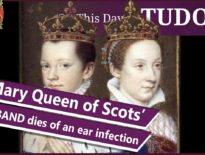On this day in Tudor history, 6th December 1573, soldier and administrator, Sir Hugh Paulet, died at his home in Hinton St George in Somerset.
He distinguished himself as a soldier in Henry VIII's reign, served as Governor of Jersey in Edward VI's reign, was a Protestant but survived Mary I's reign and served as Vice-President of the Welsh marches, and had a successful career in Elizabeth I's reign. He was an important man and a servant of the Crown, but still managed to die a natural death at his home.
Find out more about Sir Hugh Paulet, his life and career, in today's talk.
You can find out more about his son, who was asked to assassinate Mary, Queen of Scots, in this video:
Last year, I talked about the Feast of St Nicholas, which is the 6th December, and how it was the traditional day for a boy bishop to be elected. Find out more about the tradition, why Henry VIII banned it, and how it’s been revived today, in last year’s video:
Also on this day in history:
- 1549 – Death of John Wakeman (born Wiche), Abbot of Tewkesbury and Bishop of Gloucester, in Forthampton, Gloucestershire. He took the name Wakeman when he surrendered his monastery to the commissioners in 1540.
- 1555 – Death of Thomas Cottisford, clergyman, translator and reformer, at Frankfurt while in exile in Mary I's reign. In Edward VI's reign, Cottisford published a translation of Zwingli's confession of faith.
Transcript:
On this day in Tudor history, 6th December 1573, soldier and administrator, Sir Hugh Paulet, died at his home in Hinton St George in Somerset. He was buried in the parish church there.
Paulet distinguished himself at the Siege of Boulogne under Henry VIII and served Edward VI as Governor of Jersey. In Mary I's reign, he was made Vice-President of the Welsh marches, and in Elizabeth I's reign he served as a special adviser to Ambrose Dudley, Earl of Warwick, at Le Havre. So, an important man, and it’s amazing that he managed to serve four Tudor monarchs and died a natural death!
Let me tell you a bit more about this Tudor man…
• Sir Hugh Paulet was born in the first decade of the 16th century and was the eldest son of landowner and soldier Sir Amias Paulet and his second wife, Laura Keilway.
• Paulet was admitted to Middle Temple, one of London’s four inns of the court, at some point in his youth, and in 1530 he married Philippa Pollard, daughter of Sir Lewis Pollard. The couple went on to have 5 children, 3 sons and two daughters.
• In 1532, Paulet served on the commission of peace for Somerset, and in 1534 he became steward to the Bishop of Bath and Wells, a post held previously by his father.
• In 1535, he served as a commissioner for Thomas Cromwell’s valor ecclesiasticus, a survey of the finances of the church, and on 18th July 1536 he was knighted. It is thought that he came to Cromwell’s notice through the influence of his brother-in-law, Richard Pollard.
• In late 1536, at the outbreak of the Pilgrimage of Grace rebellion, Paulet was called to Ampthill to attend on the king and then he led 300 men against the rebels. In 1536 and 1537 he also served as Sheriff of Somerset and Dorset.
• In 1539, Paulet was appointed to inspect coastal defences in Somerset and served on the council of the west in 1539 and 1540, and as a senior knight of the shire for Somerset at Parliament.
• In the 1540s, he served as sheriff for the counties of Devon, Somerset and Dorset, and in 1544 he served the king in France, distinguishing himself at the siege of Boulogne. He then acted as treasurer of Boulogne from 1544 to 1546.
• In 1549, at the fall of Edward VI’s uncle, Thomas Seymour, Paulet was sent to Seymour’s house at Bromham, in Wiltshire, to take charge of the property. He then served under John Russell, as Knight Marshal, against the rebels of the Prayer Book Rebellion, leading, with Sir Peter Carew, troops that defeated the main body of rebels at King’s Weston in Somerset on 27th August 1549.
• On the fall of Edward Seymour, Duke of Somerset and Lord Protector, who had been Governor of Jersey, Paulet was sent to the island, where he dismissed Somerset’s lieutenant and reported back on the state of the fortifications. In March 1550, Paulet was made Governor of Jersey for life, and he set about using money from the church there to modernise the island’s fortifications. He also set about enacting Protestant Reforms there, for example, ordering the Book of Common Prayer to be translated into French, but then the Catholic Mary I came to the throne.
• Even though he appears to have been a staunch Protestant, Paulet was obviously able to put his faith to one side and conform in Mary I’s reign. He held on to his governorship under Mary, appointing his conservative brother John as dean of Jersey, but no Protestants were burnt on the island for heresy.
• From 1559, following the accession of Elizabeth I, Paulet passed the day to day administration of Jersey to his son, Amias, who was appointed lieutenant, while he returned to England. In 1559 Paulet served as Vice President of the Welsh Marches.
• In 1560, Paulet, who had been widowed at some point, married Elizabeth Blount, daughter of Walter Blount and widow of Sir Thomas Pope. The marriage was childless.
• In December 1562, Paulet was sent to Le Havre, or Newhaven as the English called it, as special advisor to Ambrose Dudley, Earl of Warwick, following the handing over of Le Havre to Elizabeth by the Huguenots according to the terms of the Treaty of Hampton Court. Unfortunately, Paulet and Warwick had to negotiate the town’s surrender to France in July 1563 following a siege and heavy bombardment.
• Following his return from Le Havre, Paulet settled at his home in Hinton St George in Somerset, serving on the commission of the peace for Dorset, Somerset and Devon, and as a Member of Parliament.
• Sir Hugh Paulet died on 6th December 1573 and was laid to rest in a tomb he’d commissioned for himself and his first wife, Philippa at the local church.
• Trivia: His eldest son, Amias, was the Sir Amias Paulet who served as gaoler to Mary, Queen of Scots, and the man who Elizabeth I wanted to quietly do away with the queen under the Bond of Association so she didn’t have to execute her!



Leave a Reply